You are viewing 1 of your 1 free articles
Game of throws part II: upper extremity injuries
While George R.R. Martin says, “Some old wounds never truly heal, and bleed again at the slightest word," in his epic series Game of Thrones, this doesn’t have to be the case for those soldiering on in water polo matches. In part II of this series, Alicia Filley advises on how to manage upper extremity injuries and maintain shoulder health.

The ‘arm’ory
Water polo athletes are doubly at risk for a shoulder injury, being both swimmers and overhead throwers. In fact, up to 80% of water polo players complain of a painful shoulder, and the incidence increases with the level of play1. The overhand throw used in water polo is similar to a baseball pitch but without the assistance of a base of support. Therefore, the trunk moves as one unit, unlike the segmented rotation in a baseball pitch, contributing only 30% - 35% of the speed producing force acted upon the ball; and leaving the shoulder to provide the remainder1,2.
The muscles of the rotator cuff, the supraspinatus, the infraspinatus, the teres minor, and the subscapularis (SITS), are responsible for stabilizing the humerus within the shallow glenoid fossa, depressing the humerus during shoulder movement, and performing both internal and external shoulder rotation (see figure 1). These muscles fatigue more rapidly in water polo due to increased activation in the head-up swimming posture when compared to freestyle swimming1.
When muscles are strained due to overuse, improper technique, or muscle imbalances, they can suffer from hypoxia, which results in cell death or apoptosis. Early cell death within the tendon, termed tendinopathy but more commonly referred to as tendonitis, is treated effectively with heavy, slow resistance training and strengthening, and correct technique. (Search our extensive library for more on how to treat shoulders, rotator cuff injuries, and tendinopathy) Too much stress and the tendon degenerates beyond repair and may eventually rupture. Therefore, it’s important to monitor any complaints of shoulder pain closely so that tissue stress can be treated while the injury is still minor.
Figure 1: Lateral view of the shoulder, visualizing the rotator cuff muscles as they attach to the humerus, stabilizing it in the glenoid fossa.
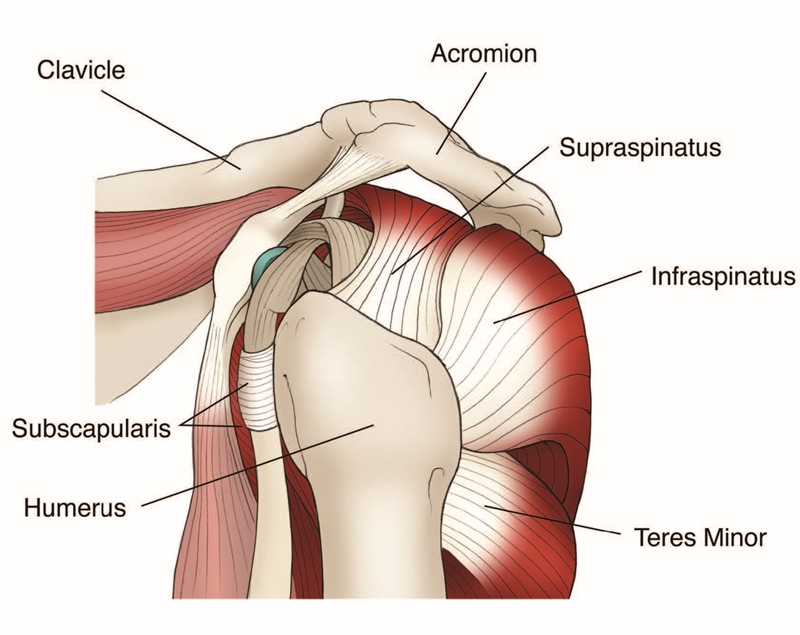
In water polo, complete rotator cuff tears are usually the result of a traumatic shoulder dislocation. An anterior dislocation occurs when an opponent, or the ball, force the cocked throwing arm into further abduction and external rotation and push the humerus out of the joint socket. Subluxation, joint separation without complete dislocation, can also tear various supporting structures within the joint. The athlete with a dislocation will likely need assistance to get to the side of the pool. Trainers can reduce the shoulder poolside, but an evaluation by a physician will determine the extent of the damage to the joint complex. Follow the short period of shoulder immobilization after reduction with physiotherapy to return strength and mobility. Repeated dislocation or complete joint rupture require surgical fixation. (For a complete review on shoulder instability and how to prevent abnormal joint movement, see Tracy Ward’s excellent article here.)
Posterior shoulder dislocation or acromioclavicular dislocation (also known as AC separation) occur in the defender who blocks the shooter’s arm with his straight arm (shoulder flexed, elbow extended). The shooter’s arm pushes the defender’s arm backward and forces the humerus out of the joint capsule posteriorly and inferiorly. As the scapula glides unhindered posteriorly, the underlying ribs stop the adjoining clavicle. When this happens, the joint between the scapula and the clavicle separates, and with sufficient force, the clavicle may fracture. Chris Mallac’s two-part Masterclass on the acromioclavicular joint is an excelent primer for those treating athletes with this pathology.
Swimmer’s shoulder, a generic name for shoulder joint impingement syndrome, plagues water polo athletes as well. As the muscles of the rotator cuff fatigue, they lose their ability to depress the humeral head as it moves, causing it to migrate upward toward the acromion. The altered shoulder mechanics place the bursa, tendons - and the joint capsule itself, if very lax - at risk of getting caught between the structures. Strengthening the shoulder stabilizing muscles improves shoulder mechanics, and proper swimming technique prevents the impinged structures from tearing and relieves the pain.
Seeing as the arsenal for propulsion and scoring lies in the shoulder, it’s a good idea to maintain preventative shoulder health through a targeted strengthening program. Endure your team’s collective groan as they tire of working out the easily fatigued and decidedly unsexy shoulder stabilizing muscles. It will help keep your front line in the water, and the reserves ready for action (see figure 2).
Figure 2: FINA recommends strengthening the core, the scapular muscles, and the rotator cuff for optimum shoulder health. The following are a few unique exercises to add to your team’s current regiment.
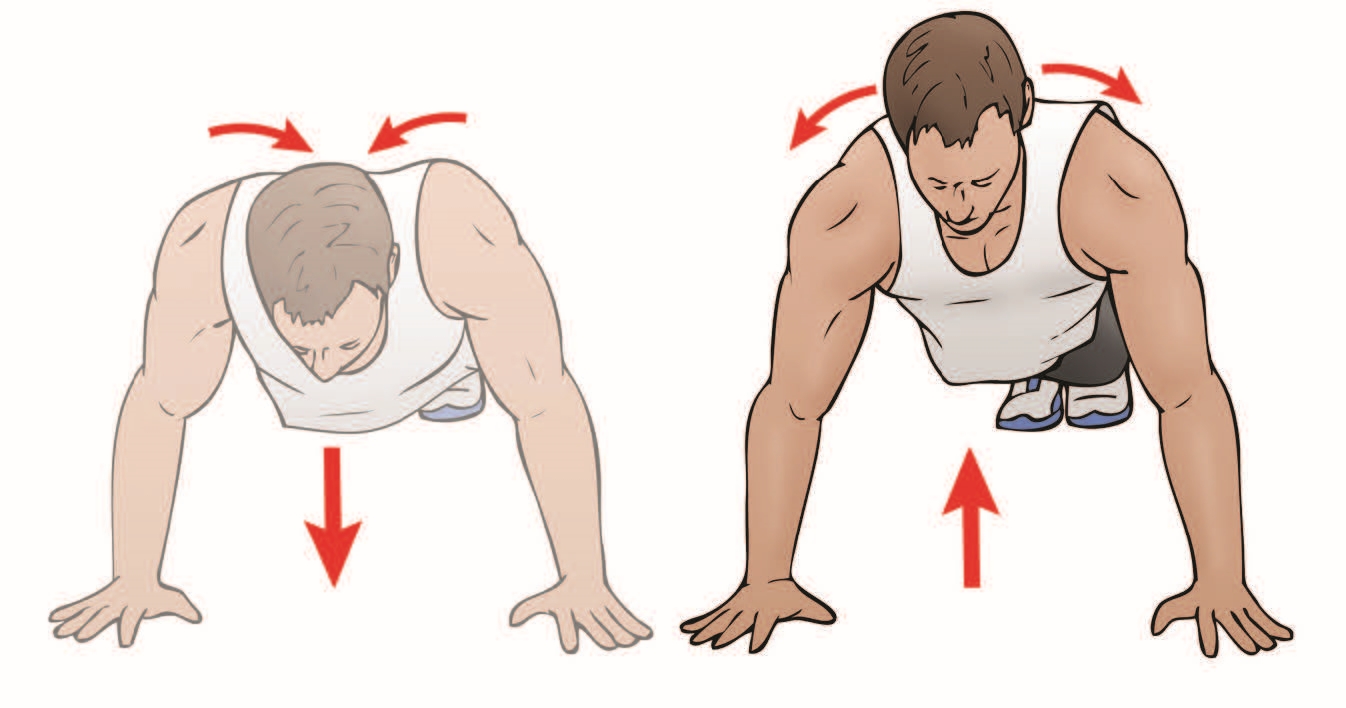
The scapular push-up: Assume the pushup position. Lower your chest toward the floor while keeping the arms straight. Push up, rounding the upper back. Perform three to six sets of 20 reps.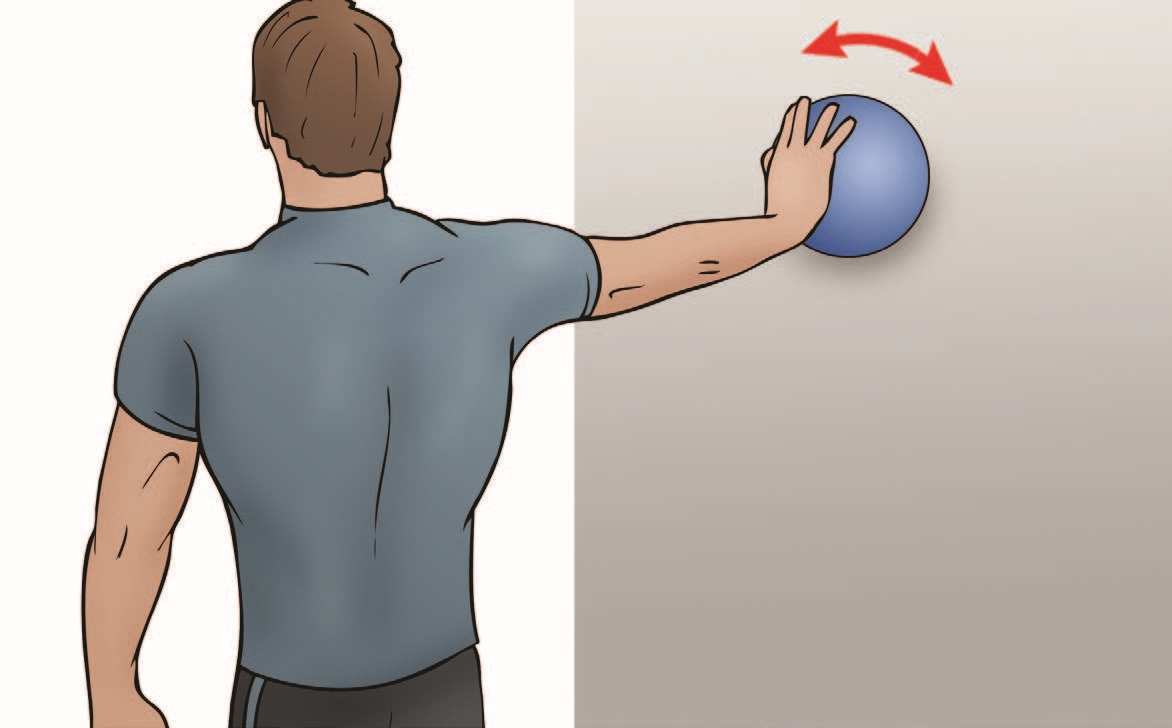
Scapular clock exercise: Standing with your side to the wall, place your hand on a small ball against the wall. Rotate the ball clockwise, then counter-clockwise in small circles for 30 seconds in each direction. Perform three to six sets.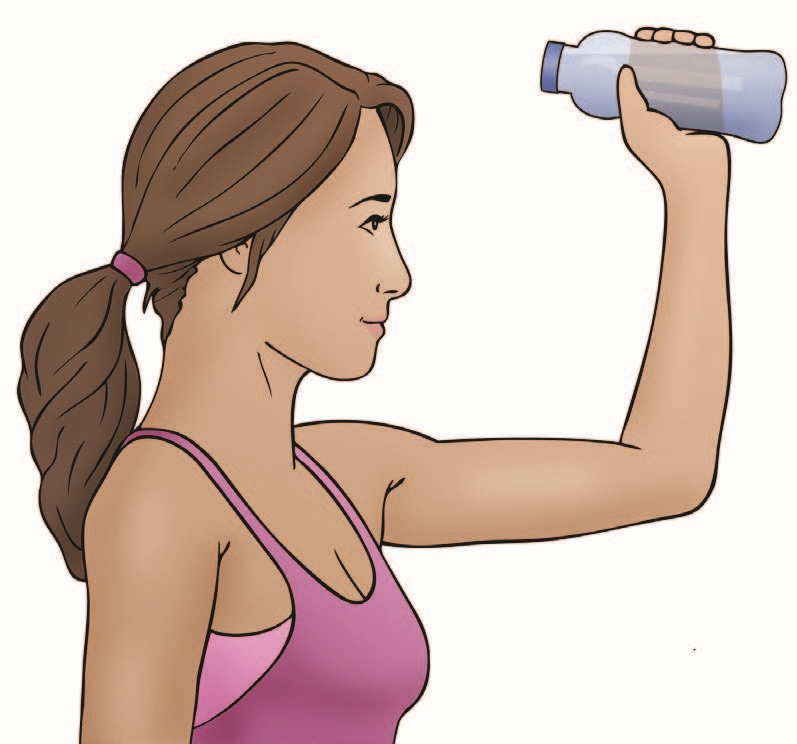
Shake it up exercise: Holding a water bottle in hand with the elbow and shoulder flexed to 90°, shake the bottle back and forth for 30 seconds in each arm. Repeat six to 10 times. Make the exercise more challenging by adding more water.
Keeping up the barrage
The only way to score in water polo is to throw the ball in the goal – and water polo athletes do lots and lots of throwing. Without the benefit of a solid base of support, the water polo athlete must generate the majority of the power for the throw from the arm. The throwing, rather than the swimming, causes elbow injuries.
The ulnar collateral ligament (UCL) connects the humerus with the ulna medially and provides the majority of valgus stability to the elbow (see figure 3). It fails with loads of more than 260 N4. The forces generated during the water polo throw often exceed this, resulting in micro-tears in the ligament5. Injury to the UCL produces pain along the medial elbow. Isolated UCL injuries usually respond well to conservative treatment of rest, physiotherapy modalities, and strengthening supporting muscles. Acute ruptures require surgical fixation. (See Trevor Langford’s review here for more on diagnosing UCL injuries.)
When the UCL repeatedly fails to stabilize the elbow, traction forces act upon and stretch the other medial structures. The elbow moves into valgus and the lateral components of the joint compress under the force. At the extremes of extension, posterior shear forces jam the olecranon process into the humerus. This failure in joint mechanics is commonly known as thrower’s elbow.
Symptoms of pain in the posterior-medial elbow, especially in full extension, usually improve with conservative treatment. The use of bracing or taping to limit full elbow extension relieves the strain and still allows play. Surgical intervention is rare but warranted if symptoms persist.
Osteochondritis dissecans (OCD) is also likely caused by the valgus stress at the elbow during throwing3. OCD occurs when a piece of cartilage on the humeral capitulum separates from the underlying subchondral bone. Athletes may complain of pain and swelling, accompanied by locking or catching at the joint. More common in the young, OCD can occur in adults with repetitive throwing. Researchers in Croatia even suspect that untreated elbow hyperextension injuries, common in goalkeepers, may progress to OCD3. Rest and physical therapy usually allow the separation to heal, but unresponsive cases require surgical fixation.
Ulnar nerve compression, known as cubital tunnel syndrome, can also cause medial elbow pain (see figure 4). An anomalous accessory muscle, known as the anconeus epitrochlearis, may be the source of this compression. For details on this rare but detrimental condition, see Adam Smith’s excellent review of the case of cubital tunnel syndrome in a water polo player here.
Figure 3: Anatomy of the medial elbow joint. Approaching 90° of elbow flexion, the ulnar collateral ligament provides 54% of the stability against valgus stress4.
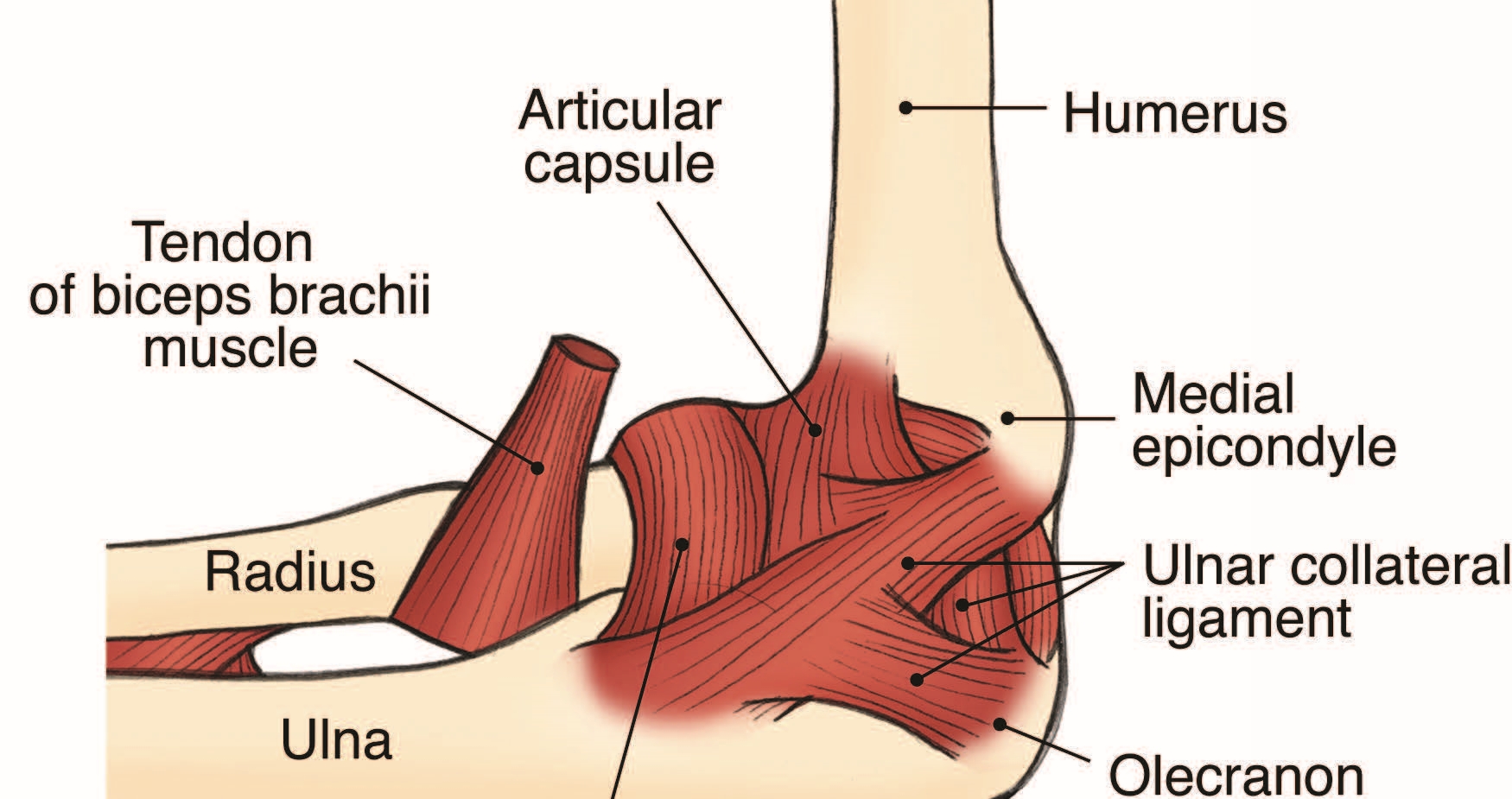
Figure 4: Accessory muscles of the elbow leading to ulnar nerve entrapment
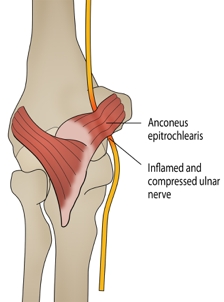
Hand to hand combat
Most of the injuries that happen to the fingers and hand are acute and traumatic. Battling over the ball causes lacerations, dislocations, and fractures. The most common laceration is a tear in the webspace between two fingers. The repair can be a simple closure of the wound or surgical intervention to reattach torn tendons and ligaments. Catching a forcefully thrown ball can cause a hyperextension dislocation of a finger. Closed reduction is usually simple and the player can play with the finger ‘buddy taped’ if the complaints of pain are minimal. Various fractures are treated appropriately with splinting or surgical pinning.
Triumph
Although not mortal combat, water polo is a physiologically demanding and aggressive sport. The physicality of the game means that injuries are often traumatic, and yet, the repetitiveness of the sport makes for numerous chronic injuries as well. It’s not uncommon for athletes to have battle scars from water polo. Keep the regiment as healthy as possible through dry land strengthening, and attention to swimming and throwing technique, so your team can ascend to the throne of victory.
References
- Croat Med J. 2007;48:281-8.
- Alexander M, Hayward J, Honish, A. Water Polo: A Biomechanical Analysis of the Shot. Unpublished research report prepared for Water Polo Manitoba, The University of Manitoba, April, 2005.
- 2013 Sep;44 Suppl 3:S46-8.
- HSS J. Feb 2006; 2(1): 83–93.
Further reading
Newsletter Sign Up
Subscriber Testimonials
Dr. Alexandra Fandetti-Robin, Back & Body Chiropractic
Elspeth Cowell MSCh DpodM SRCh HCPC reg
William Hunter, Nuffield Health
Newsletter Sign Up
Coaches Testimonials
Dr. Alexandra Fandetti-Robin, Back & Body Chiropractic
Elspeth Cowell MSCh DpodM SRCh HCPC reg
William Hunter, Nuffield Health
Be at the leading edge of sports injury management
Our international team of qualified experts (see above) spend hours poring over scores of technical journals and medical papers that even the most interested professionals don't have time to read.
For 17 years, we've helped hard-working physiotherapists and sports professionals like you, overwhelmed by the vast amount of new research, bring science to their treatment. Sports Injury Bulletin is the ideal resource for practitioners too busy to cull through all the monthly journals to find meaningful and applicable studies.
*includes 3 coaching manuals
Get Inspired
All the latest techniques and approaches
Sports Injury Bulletin brings together a worldwide panel of experts – including physiotherapists, doctors, researchers and sports scientists. Together we deliver everything you need to help your clients avoid – or recover as quickly as possible from – injuries.
We strip away the scientific jargon and deliver you easy-to-follow training exercises, nutrition tips, psychological strategies and recovery programmes and exercises in plain English.











